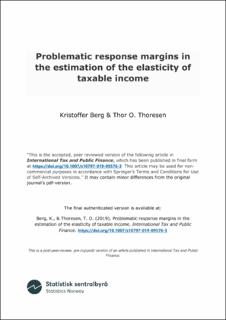| dc.contributor.author | Berg, Kristoffer | |
| dc.contributor.author | Thoresen, Thor Olav | |
| dc.coverage.spatial | Norway | en_US |
| dc.date.accessioned | 2020-04-02T09:59:00Z | |
| dc.date.available | 2020-04-02T09:59:00Z | |
| dc.date.created | 2019-11-22T15:47:51Z | |
| dc.date.issued | 2019-10-30 | |
| dc.identifier.citation | Berg, K., & Thoresen, T. O. (2019). Problematic response margins in the estimation of the elasticity of taxable income. International Tax and Public Finance. | en_US |
| dc.identifier.issn | 0927-5940 | |
| dc.identifier.uri | https://hdl.handle.net/11250/2650057 | |
| dc.description.abstract | The elasticity of taxable income (ETI) holds the promise of representing a summary measure of tax efciency costs, which means that further information about the behavioral components of the ETI is not required for its use in tax policy design. However, since there are response margins that can cause biases in the estimation of the elasticity, this paper warns against neglecting information about the composition of the behavior summarized by the ETI. When using responses of the Norwegian self-employed to the tax reform of 2006 for illustration, we discuss how three diferent response margins relate to the overall ETI: working hours, tax evasion and shifts in organizational form. We provide empirical illustrations of efects of each of these margins and argue that the standard procedure for estimating the ETI produces a biased estimate due to the organizational shift margin. | en_US |
| dc.language.iso | eng | en_US |
| dc.publisher | Springer | en_US |
| dc.rights | Navngivelse-Ikkekommersiell-DelPåSammeVilkår 4.0 Internasjonal | * |
| dc.rights | Navngivelse-Ikkekommersiell-DelPåSammeVilkår 4.0 Internasjonal | * |
| dc.rights.uri | http://creativecommons.org/licenses/by-nc-sa/4.0/deed.no | * |
| dc.subject | Tax evasion | en_US |
| dc.subject | Skatteunndragelse | en_US |
| dc.subject | Self-employed | en_US |
| dc.subject | Elasticity of taxable income | en_US |
| dc.subject | Skatteinntekter | en_US |
| dc.subject | Selvstendig næringsdrivende | en_US |
| dc.title | Problematic response margins in the estimation of the elasticity of taxable income | en_US |
| dc.type | Peer reviewed | en_US |
| dc.type | Journal article | en_US |
| dc.description.version | acceptedVersion | en_US |
| dc.subject.nsi | VDP::Samfunnsvitenskap: 200::Økonomi: 210 | en_US |
| dc.source.pagenumber | 32 | en_US |
| dc.source.journal | International Tax and Public Finance | en_US |
| dc.identifier.doi | 10.1007/s10797-019-09576-3 | |
| dc.identifier.cristin | 1751198 | |
| dc.relation.project | Norges forskningsråd: 219616 | en_US |
| dc.relation.project | The funding was provided by Norges Forskningsråd (NO). Norges forskningsråd: 219616. Norges forskningsråd: 267428 | en_US |
| cristin.unitcode | 5932,5,0,0 | |
| cristin.unitname | Forskningsavdelingen | |
| cristin.ispublished | true | |
| cristin.fulltext | original | |
| cristin.qualitycode | 1 | |

